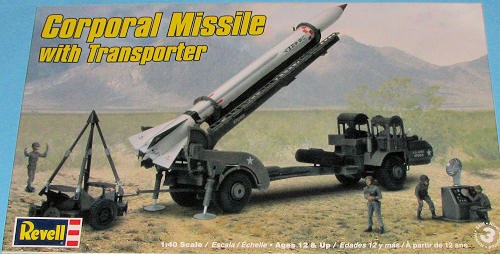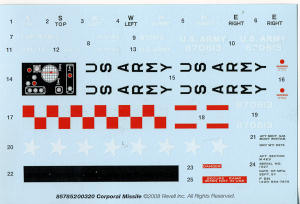
Revell 1/40 Corporal Missile with Launcher and Trailer
| KIT #: | 7852 |
| PRICE: | $29.95 MSRP |
| DECALS: | One option |
| REVIEWER: | Scott Van Aken |
| NOTES: | Reissue |

| HISTORY |
The MGM-5 Corporal missile was the first Guided Weapon authorized by the US to carry a nuclear warhead. A surface-to-surface guided missile, the Corporal could deliver either a nuclear fission or high-explosive warhead up to a range of 75 nautical miles (139 km).
Developed by the United States Army in partnership with Firestone Tire and Rubber Company, Gilfillan Brothers Inc, Douglas Aircraft Company and Caltech’s pioneering Jet Propulsion Laboratory, the Corporal was designed as a tactical nuclear missile for use in the event of Cold War hostilities in Eastern Europe. The first U.S. Army Corporal battalion was deployed in Europe in 1955. Six U.S. battalions were deployed and remained in the field until 1964, when the system was replaced by the solid-fueled MGM-29 Sergeant missile system.
The Corporal was first developed in White Sands Missile Range, New Mexico drawing on the technical experience and expertise that the Americans acquired from the German V-2 rocket program after the Second World War. After being sold to Britain in 1954, it became the first US guided missile destined for service in a foreign country to be used by a foreign power. Subsequent test-firing by British and German Corporal battalions took place in the Scottish island of South Uist in 1959, where a special Royal Artillery 'Rocket Range' was built in 1957-58.
For what was the front line of nuclear defense, the Corporal missile was notoriously unreliable and inaccurate. It used a liquid-fueled rocket burning red fuming nitric acid and hydrazine; this required elaborate and time-consuming preparation immediately before launch, making its tactical responsiveness questionable. For guidance, it employed commands sent through a reworked Word War II-era radar system. Until 1955, its in-flight accuracy was less than 50 per cent, with only modest improvements thereafter. The first year of British test firings in 1959 yielded a success rate of only 46%, a dismal record which raised questions among military planners of its operational effectiveness in Germany.
| THE KIT |
This is a much appreciated reissue of the Revell kit from the 1960s. It may have been an Adams kit as Revell did buy out this company after it went bankrupt. However, Revel also produced a few military kits in 1/40 scale, which was one of two popular armor scales (the other being 1/32) until Tamiya started producing military vehicles in 1/35. As much as I'd like to show the sprues on this one, there are just far too many and Revell USA does not included a parts layout in their instructions. Suffice it to say, there are a lot of parts and the box art shows a build up.
The condition of the molds is actually quite good considering their age. I am sure that fit will be less than optimal by today's standards and you will find the usual ejector pin marks and part numbers embossed on many of the larger bits. One has to keep in mind that having things move was very much a priority during the early days of kit production and so authenticity often was subordinated to having functional segments.
The missile itself only takes up a small portion of the assemblies with the launcher assembly, that part that allows it to stand on its own in readiness for firing, taking up another larger percentage and finally the tractor and trailer assembly taking up the majority of the parts. There is a crew included and while there is no clear styrene for windows an acetate sheet is included to handle that task. the instructions provided a cutting guide for the various windows.
As you can imagine, the trailer has all the missile hold downs articulated and you can build the elevation mechanism so that it can raise and lower with the missile. The rather odd looking low pressure tires are in plastic and are designed to roll with the front wheels steerable. If you have ever built the Revell 1/69 V-2 kit, you'll find many of the assemblies to be familiar, though of a different scale and shape. A set of vinyl tires is included to be used with the launcher assembly. Thanks to all the functional parts, this can be displayed ready to fire or in transport mode.
to be familiar, though of a different scale and shape. A set of vinyl tires is included to be used with the launcher assembly. Thanks to all the functional parts, this can be displayed ready to fire or in transport mode.
The 16 page instruction booklet is nothing like what was produced in the 60s with modern and well done construction drawings. All the parts are named and colors provided. Decals look to be well done and are in register. They seem a tad thick compared to some, but should be quite viable. Markings are for one missile as shown on the box art and I have a suspicion that it is for a test missile as images found on the net are not quite so flamboyant.
| CONCLUSIONS |
Nice to see these older kits reissued. Not only does it mean we get them for a fraction of collector's prices, but they come with better decals as well.
| REFERENCES |
http://en.wikipedia.org/wiki/Corporal_missile
June 2010
Thanks to me and impulse buying for this one.
If you would like your product reviewed fairly and fairly quickly, please contact the editor or see other details in the Note to Contributors.